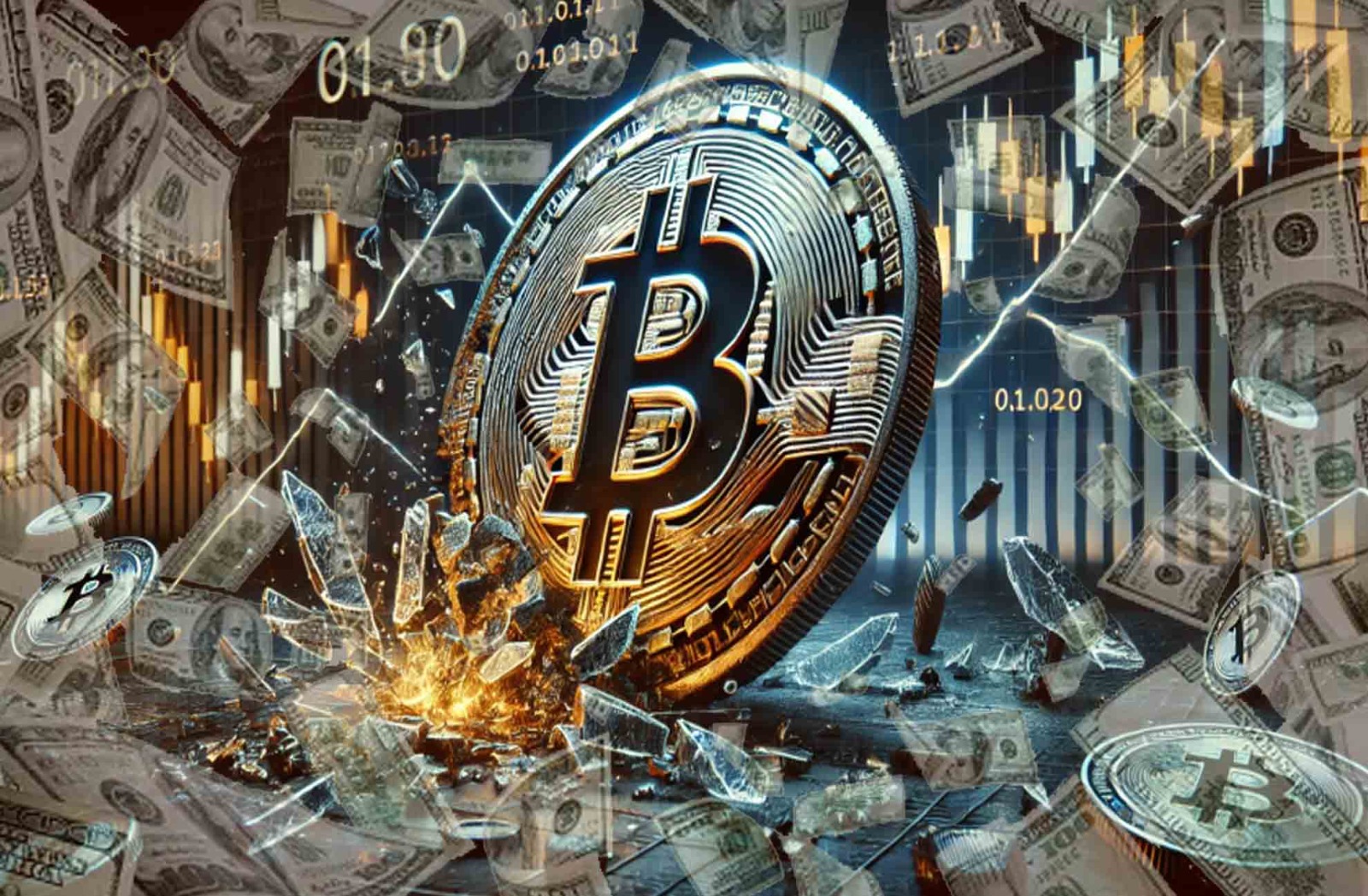What if the unthinkable happens? Imagine the United States dollar, the foundation of global finance, collapsing in front of our eyes. Could this financial cataclysm herald a golden age for Bitcoin and the broader cryptocurrency market? Buckle up, because the answers may just blow your mind. Let’s go down the rabbit hole and investigate the possible consequences of a dollar collapse on the realm of digital currencies.
Introduction
The global economy is currently experiencing tremendous upheaval. Many countries are experiencing high inflation rates, supply chains are still recovering from the COVID-19 outbreak, and geopolitical tensions are creating economic uncertainty. Central banks, particularly the Federal Reserve, are attempting to strike a careful balance between preventing inflation and promoting growth. Financial markets are extremely volatile, reflecting broad concerns about the future. The United States dollar is the world’s most important currency. It is the world’s major reserve currency, which gives it tremendous power.
Central banks all across the globe keep a large amount of their reserves in dollars, and many commodities, notably oil, are priced in dollars, making it an important player in international trade. Because of the dollar’s supremacy, price variations can have far-reaching consequences. A strong currency can stifle global trade by making US exports more expensive and raising the cost of dollar-denominated debt in other countries. A weak dollar, on the other hand, can encourage global trade while also contributing to global inflation. The stability of the US dollar is thus critical to preserving global economic stability.
Even while it may appear unlikely, a collapse of the US currency is not completely impossible. Numerous things might lead to such a situation, such as extreme inflation, an unmanageable national debt, a decline in trust in American economic policy, or a significant shift in geopolitics. A dollar collapse would have devastating effects on the world economy as a whole as well as the United States.
U.S Dollar Index Decline
Economist and gold bull Peter Schiff said on X, “The U.S. Dollar Index just hit a new 2024 low [and it’s] actually still relatively high, but it looks like it’s on the verge of a total collapse.” Later, Schiff—a bitcoin and cryptocurrency critic and the founder of money management Euro Pacific Asset Management—added, “The index could easily sink below 90 before year-end, challenging the 2020 low.” “I think that low will be breached in 2025, triggering a U.S. dollar crisis, crashing the economy, and sending consumer prices and long-term interest rates soaring.”
Factors contributing to the dollar’s decline
In the context of the US dollar, currency depreciation is the term used to describe the dollar’s decrease in value in relation to another currency. The currencies are said to be at parity, for instance, if one US dollar may be traded for one Canadian dollar. In the event that the exchange rate fluctuates and one US dollar is now worth 0.85 Canadian dollars, the US dollar has depreciated against the Canadian dollar due to its decline in value. The value of the US dollar might decline due to a number of economic reasons. These include changes in monetary policy, inflation or price increases, currency demand, economic expansion, and export pricing.
The value of the US dollar and its impact on the world economy are largely determined by monetary policy. The Federal Reserve injects additional money into the economy to spur growth through quantitative easing (QE) or interest rate adjustments. But because expanding the money supply devalues currency, this “easy” monetary policy may make the dollar weaker. The dollar may weaken even further as a result of reduced interest rates encouraging investors to look for better profits abroad. The dollar’s value is also affected by inflation. Increased prices for American goods abroad may result from more inflation in the country, which would lower demand and devalue the dollar. In contrast, imported items gain popularity, which could depress the value of the currency. Because dollars are frequently used in international transactions, particularly those involving commodities like oil, the U.S. dollar has a strong position as the world’s major reserve currency.
However, demand for the dollar may decline and cause a depreciation if other currencies become reserve currencies or if oil producers accept other currencies. Important responsibilities are also played by trade balances, investor confidence, and economic growth. A robust US economy sustains the value of the dollar; a weakening of the currency could result from slowing growth or worries about US debt. All things considered, monetary policy is the primary driver of the intricate interactions that shape the value of the dollar.
Could the US Dollar Collapse?
Emerging economies around the world are challenging American hegemony and attacking one of its most potent weapons—the currency. Although the US dollar has been gradually losing value over the past few decades, it is now under attack from resurgent China and revanchist Russia, who are attempting to reshape the geopolitical environment in the wake of the wars in the Middle East and Ukraine. The dollar’s dominance over its main rivals as a reserve currency is still undeniable, but it is losing ground. The Federal Reserve is injecting money into the system in an attempt to support the US economy, a move that many economists believe is unsustainable. Nigel Green, the CEO and founder of the deVere Group, cautioned on Tuesday, April 30, that in the event that a course correction was not made, the dollar might follow the path taken by the Japanese Yen, which is currently experiencing a severe crisis.
At its meeting in May, the Fed decided to keep interest rates the same. Prior to the announcement, Mr. Green stated: “Japan has enormous debt—260 percent of its GDP—which is the reason the yen is collapsing.” The US has much more than 100% debt.Although Japan must raise interest rates, but if it raises interest rates, it causes its own borrowing to become more expensive, and it can’t afford to repay its debts. It is investing up to $40 billion a day in an effort to protect its currency. That hasn’t worked in the past and is only temporary. In the end, borrowing is the issue, and America is going in the same direction. Even though the dollar isn’t there yet, if they continue to borrow money, it will be. Nations will run into problems if they simply keep borrowing money.
Bitcoin and Crypto Market Surge
As September approaches, the price of bitcoin has persisted in its recent downward trend. September is often a difficult month to keep bitcoin. Analysts at the Bitfinex cryptocurrency exchange stated in emailed comments that “September has historically been a volatile month for bitcoin, with an average return of 4.78% and a typical peak-to-trough decline of 24.6%.” The researchers cautioned that if the Federal Reserve sticks to its widely expected plan to lower interest rates during its meeting in September, there’s a chance that the price of bitcoin may plummet below $40,000.
“The conclusion of the summer trading lull, when fund managers return from vacation and human-driven trading activity picks up, is sometimes blamed for this volatility.
A further layer of complication is added with the expected rate cut in September, which might exacerbate market volatility. This September historical price movement is also consistent with our prediction that the price of bitcoin will fall by 20% as a result of a rate cut. It is noteworthy, though, that historical patterns also indicate that September has occasionally exceeded expectations and produced positive returns when August closes in the red.
This might offer refutation to the notion that September will inevitably be a gloomy month for bitcoin.” The Fed Chair Jerome Powell’s speech last month at the annual central bankers’ symposium in Jackson Hole, Wyoming, set the stage for a September interest rate decrease, which depreciated the US currency, by striking a dovish tone.
According to Neil Roarty, an analyst at the investing platform Stocklytics, “it’s been a tough summer for the greenback,” in an email. “The dollar’s domination appeared invincible as recently as April, when its value surged against nearly all other world currencies. It is now trading at 2024 lows versus the yen, the pound, and the euro.”
Role of Federal Reserve policies in influencing crypto markets
The minutes of the July meeting of the Federal Open Market Committee showed an unexpected turn toward dovishness, indicating that the Fed may start reducing rates earlier than expected, despite having aggressively raised interest rates to 23-year highs during the Biden administration in an effort to combat the highest level of inflation since the 1980s. Growing rumors suggest that before year’s end, the Fed may cut rates by as much as 100 basis points, which would lower expectations for the dollar for the remainder of 2024. Significant currency volatility is expected as a result of this decision, especially as additional central banks, like the Bank of England and the European Central Bank, are also anticipated to keep lowering interest rates.
The unanticipated rate increase by the Bank of Japan in July has already increased uncertainty in the global Markets. The initial surge in value of Bitcoin over the first half of 2024 has now subsided. The digital asset market may be on the verge of a crucial turning point in September, according to 10x Research, which has issued a warning due to the weakening market fundamentals and the increasing severity of each price decline.
Federal Reserve’s Monetary Policy
Concern has been expressed by several observers of the bitcoin and cryptocurrency markets over the cryptocurrency’s historically dismal September performance.
“September is a historically negative month for bitcoin, as data shows it has an average value depletion rate of 6.56%,” wrote Innokenty Isers in an email. He noted that the price of bitcoin has fallen from its recent peak due to the recent negative investor sentiment surrounding the cryptocurrency. Paybis is a U.K.-based bitcoin and cryptocurrency exchange.
If the Federal Reserve lowers interest rates in September, it might potentially help bitcoin erase its bad past. This is because rate reductions typically create an overwhelming influx of US dollars into the economy. As a result, the dollar’s purchasing power declines, improving bitcoin’s prospects as a store of wealth. Massive bitcoin holdings by numerous institutional investors already demonstrate this argument. It may become necessary to move to riskier assets with faster growth potential if the Fed’s actions cause the dollar to decline.
Overall, September may be a stronger month for bitcoin this quarter due to the macroeconomic indices, the introduction of spot exchange-traded funds (ETFs) for the cryptocurrency, and the positive hash rate.The much anticipated introduction of a number of spot bitcoin ETFs on Wall Street has further accelerated the price rise of bitcoin thus far this year. Since their launch in January, the bitcoin ETFs from Fidelity and BlackRock have risen to become some of the fastest rising ETFs ever.
Economic Predictions & Analyst Views
Schiff reported on August 23, saying, “The Dollar Index closed at 100.67.” Before the year is up, the index could easily go below 90, challenging the bottom from 2020.
This anticipated decline in the value of the dollar might have far-reaching effects. In general, a declining dollar makes American products more affordable and competitive overseas, which could strengthen the country’s manufacturing and export industries. “I think that low will be breached in 2025, triggering a U.S. dollar crisis, crashing the economy and sending consumer prices and long-term interest rates soaring,” says Schiff, projecting that this negative trend will continue until 2025. Schiff did not elaborate in that essay, but a sharp drop in the value of the dollar may erode foreign trust in the dollar as a medium of exchange and store of value. The ensuing economic instability may potentially have an effect on the US economy by raising the cost of servicing debt denominated in dollars, especially for foreign borrowers.
Just a few weeks ago, economists predicted many interest rate cuts in 2024. However, higher-than-expected price increases have spurred new inflation fears, making a rate decrease this year unlikely. While this means that some investors may cling onto the dollar, it also puts pressure on the expense of the US government servicing its debt, perhaps laying the groundwork for larger problems in the future.
Interest rates are unlikely to fall significantly until the Fed believes it is making headway toward its aim of reducing inflation to 2%. As recently as April, investors projected interest rates to decrease by 1.5 percent this year, but those estimates have now allegedly fallen to an average of just half a point. According to a recent Financial Times analysis, a strong dollar may cause countries to sell off the currency, disrupting trade flows and increasing inflationary pressures. Although they emphasized that any sell-off of the dollar by the US itself was improbable.
According to a recent Reuters poll of 66 analysts, most observers believe the dollar’s strong position will continue in the short future. The site reported on the findings, stating: “Despite a weakening trend late last year, the dollar has gained against nearly every currency tracked by traders and investors.”
Potential Effects of a Dollar Collapse
The collapse of the US currency would have far-reaching global consequences. The dollar serves as the world’s major reserve currency, supporting a significant amount of international trade and finance. A collapse might result in a significant increase in the cost of imports for the United States, rising inflation, and a catastrophic economic recession. Globally, countries with huge dollar reserves would suffer massive losses, causing volatility in international financial markets. This might result in a rush into alternative currencies or assets such as gold, Bitcoin, or even other fiat currencies, fundamentally altering the global financial system.
Is the US dollar still a safe haven?
Despite rising pressures from developing economies and geopolitical upheavals, the dollar remains the world’s reserve currency. However, this position is not without flaws, particularly in light of rising US debt. While analysts advise against the United States’ more than $16 trillion in debt obligations, the dollar’s demise is not imminent. However, the long-term problems of high inflation and rising debt levels should be a red flag for investors. The Federal Reserve’s efforts to support the economy through monetary stimulus create concerns about the dollar’s long-term strength. Persistently high interest rates may impede growth and raise the cost of servicing US debt.
Investors may choose to diversify their investments to mitigate the risks connected with the dollar. Gold, mutual funds, and ETFs may be viable options for people looking to preserve their investments from currency depreciation and economic uncertainty. While analysts expect that the dollar will continue to perform well in the short term, the possibility of unforeseen events triggering a crisis cannot be overlooked. As a result, it is frequently recommended that you keep a varied portfolio.
Conclusion
In summary, the potential weakening of the U.S. dollar, driven by dovish shifts in Federal Reserve policy and global economic dynamics, could lead to significant volatility in currency markets and broader financial instability. Peter Schiff’s dire predictions about the dollar’s future highlight the risks of excessive debt and monetary easing, suggesting a possible loss of the dollar’s reserve currency status with severe global consequences.
As the Fed and other central banks consider rate cuts, the implications could include rising inflation, shifting capital flows, and a reconfiguration of global financial power. These potential economic shifts underscore the importance of monitoring monetary policy decisions and their far-reaching impacts on both domestic and international markets.












































































































